Art Inundated with Metaphors—’The realm of manifestation’-a retrospective show of CS Krishna Setty
“To see is all that matters”- William Blake
Krishna Setty’s art is a reflection of personal idiom from his own imaginary gallery, a pictorial language that specifies a modernist aspiration for individuality and innovative distinction. ‘The realm of manifestation’-a retrospective show of CS Krishna Setty with 346 artworks, including paintings, sculptures, and installations—an in-house curated exhibition by the National Gallery of Modern Art Bangalore—was inaugurated on 9th December 2022, with Prabhakar Kolte-renowned artist, as Chief Guest, – Adwaita Gadanayak, Director General, NGMA, as Guest of Honour. The gallery walk of KV Subramanyam, an art critic, was another appeal to the exhibition. There was a panel discussion in conjunction with the ongoing exhibition, with Dr RH Kulkarni, an art historian, as Moderator and Nalini Malaviya, an art writer, Ravi Kumar Kashi, an artist, and Alka Chadha Harpalani, an artist and writer as the panellists. It was further followed by the demonstration by the artist.
The first step towards the gallery and the visual treat is a huge installation of a ‘boat’ in the pond in NGMA, laden with chairs tumbled over, haphazardly balancing upon each other. This being a reflective show displaying years of work, the boat has been represented for a lifelong journey. The chairs can be a reflection of multiple posts held by the artist in his life or even a not-so-easy, step-by-step progress to recognition, echoing his cardinal virtues as an artist, art critic, organiser and writer, administrator, or even public relations officer. The seriousness has been blended with playfulness, where boulders made up of foam float in demarcated space yet break free to move in any direction. Crocodiles made up of fibreglass have been added for bounciness in the water but can be cueing at some ferocious oddity or as a hindrance. A smaller boat with an oar upright in it, with tiny pebbles inside the frame of the boat, stands as a part of another installation inside the gallery space.
Whether its thematic configuration of giving a message or construing a known fact, unceasing pursuit of symbolic manifestations and indices, exuberance of colours, lyrical distortion of images, fantasy, and Indigenous elements—all reveal the personal synthesis of the artist. The hushed yet loud statement is made, and there is an extension of the theme to the entire body of artworks. In this compulsive enchantment, one can observe surrealism intermingled with hilarity and wit, articulating through the trees, which might have legs and fish, and snakes that might be seen budding from the plants. The compositions are enriched with the disarray or haze of imprints, instincts, and derive-excerpts from his subconscious dominion. Most attention-grabbing things one creates with the stuff one ignores or flings away. There is no doubt a connotation and overtone midst resources used, borrowed, and adapted. Among the eleven installations, this is a parody of casks balanced by a skeleton of fish, where cast-off ‘barrels, rope, and baskets’ retain a built-in history. In this installation too, one comes across the creative liberty; no intractability of material or restrictions of traditional techniques. There is a wilted composure deliberated by the artist’s staging of its forms as an incorporated, coherent, sculptural mass, isolated but defining time.
The artist has the flexibility to obtain, stir, absorb, and use external stimuli and cultural exchanges to kindle vivacity and relevance in his artistic endeavours. Like the Bauhaus slogan ‘honesty of materials, the artist has not tried to change the intrinsic properties of the factual. There is an artistic freedom to express but slightly censored and left on the public to decrypt their implications, whether characteristically, socially, politically, or sexually. Old themes like snakes and fish continue but with new catchphrases. Material and treatment may have altered, but symbols never lost their command. The big ‘urli’ used in traditional kitchens in South India enwraps another installation with a human head enclosed by snakes layering out on the brink. ‘Charkha’ has been presented with all threads disorderly mirroring desuetude, pride, desertion, and abandonment—all in one. Another assemblage or an open-form installation making a mark is that of four rusted weighing scales hanging to a stand, with their eight plates holding brushes coated with dried paints, skulls, snakes, and stones. ‘Three-headed demon’ shows the evil dangling a fish in his hand. There’s a possibility of the devil occupying the dominant part of a human personality, and the risk hovers over the mind all the time, depending on whether one lets it in or not. Nostalgic ‘Letter Box’ has a snake tangled in its orifice too. ‘Tortoise’ with a snake coiled around its neck’; an ‘ox’ portraying the power and strength too has snakes glimpsing from ducts near ears, hump, and back in the mould. One observes the potential of junk in his installations and assemblages, and the elements in his paintings seem to have taken a physical form.
One section of the gallery actually appears like ‘a wall of fame’ where there is a screenplay of the reviews by eminent artists and critics, and the walls show numerous press releases and publications. Huge drawings casing the doorway and the wall adjoining the ramp give the impression to be an extension of the displayed artworks inside the gallery. There is dexterous unfolding of new forms where metaphors play a mystic part, whether it is seizing the liveliness of spirit of a woman with wings as well as the sentiment of liberty from the captivation; the estrangement instigated by technology with sensitive delineation of heads lost in the squares and triangles screening the harsh reality; a loner bird, headless reptile, masks and facades, or manifold hands gilding the head interpreting torments and atrocities dominant in the society. Krishna Setty also crosses the threshold of his world of creation, while listening to Hindustani music and tunes in to Carvaan as per his mood, and simultaneously starts his exploration of the innate gist of shapes inflowing over his canvas. The free-flowing interactions with his densities of thoughts, experiences, and stimulations all become a part of his terminologies, visual satire pertaining to society, culture, environment, and myriad concerned issues, or even simply a splash of golden in his less complicated layouts of recent works.

Image Courtesy: Alka Chadha Harpalani
Setty exquisitely exploits the accidental splurge of the ink and the controlled textures with pastels. His exposure to printmaking can be seen in the textural variations through the lines, curves, overlapping shapes, and arrays of patterns along with formalised images. The compositions may appear raw and simple with symbolic motifs but are charged with meanings and emotions. In a few words, one can wind up by saying that there is an incorporation of reality and fantasy; an intense performance of conscious and subconscious, where imaginative penchants fluctuate from verbal to spatial. The ethereal mood, evocative forms, captivating concepts—all connotations are veiled in layers, juxtaposing the narrative patterns coated in oranges, greens, yellows, greys, and intense blacks.
Read More>> Please Subscribe our Physical Magazine


